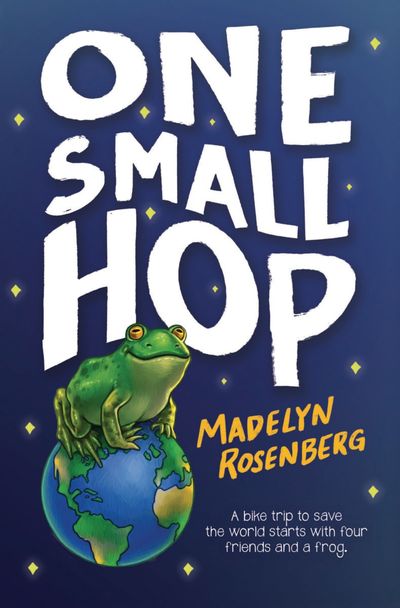‘One Small Hop’ by Madelyn Rosenberg is an adventure with a bullfrog

In “One Small Hop” by Madelyn Rosenberg, for ages 8 to 12, Ahab and his friends trace a mysterious sound to its source: a bullfrog. The frog is calling for a mate, and the kids are determined to help it. But that’s a tough mission because danger surrounds this lonely bullfrog, which could be the last one in the U.S.
The biggest danger is the toxic environment. The frog and its human champions – Ahab, Delphinium, Davy and Leroy – live in the late 21st century. The pollution and climate change we’re worried about today have gotten a lot worse. Oceans and lakes are so contaminated that swimming is forbidden.
If people want to go hiking, they must do so in a specially designed indoor space with fake trees and the recorded twitter of birds. Sound grim? This book is actually a terrific blend of funny and urgent as the friends try to figure out what to do with the frog.
By law, they are supposed to alert the Environmental Police Force, which is the agency in charge of protecting the environment. But they refuse to do that. The EPF is an incompetent joke. Under its care, the “fragile species list” (formerly known as the endangered species list) has swelled to thousands of animals.
But this means the kids can’t ask their parents for help or tell anyone about the frog. Ahab and his friends decide to smuggle it into Canada, where there may (or may not) be a suitable mate for it. Their big plan: to ride their bikes to the border and somehow cross it with the illegal frog stowed in a knapsack.
Setbacks immediately occur. The kids manage to convince their parents – who agree to let them go only if Ahab’s bossy, rule-following older sister bikes with them. Then they must deal with Davy’s very worried mother and her constant calls. Their trip is marked by blistering heat, thunderstorms and fake ice cream.
And let’s not forget the frog. Its occasional, loud calls could expose its hiding place – and wreck the whole mission. Tired and cranky, the friends squabble. Will this small band of bicyclists make it to the border, and what will they do once they get there?
As you read, you might find yourself asking big questions: How would I act in Ahab’s situation? What can I and my family and friends do now to help create a healthier planet in the future? And even how could fake ice cream ever become a favorite treat?
You might also like …
Two humorous novels about young environmental activists. In “Scat” (ages 8 to 12) by Carl Hiaasen, Nick and Marta are determined to solve a mystery involving their teacher, a panther and bad guys in the Florida Everglades.
In “Strange Birds” (ages 9 to 13) by Celia C. Pérez, four very different girls protest a tradition that stems from the harm done to millions of birds in the early 1900s.
Young readers should look for “Homer on the Case” (ages 7 to 11) by Henry Cole. In this funny, illustrated novel, a pigeon and a parrot team up to uncover the truth behind the thefts in a local park. All these kids were curious about the frogs, birds and plants in their towns and want to protect them.
In “The Outdoor Scientist: The Wonder of Observing the Natural World” (ages 8 to 13) by Temple Grandin, with Betsy Lerner, an accomplished animal scientist shares 40 fun projects to enhance your knowledge about and enjoyment of the outdoors.